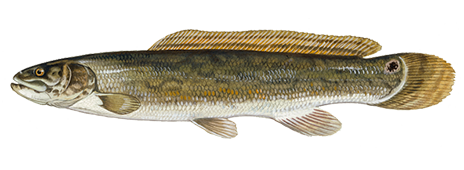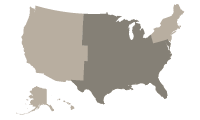
Bowfin
The bowfin is considered a living fossil as the sole surviving representative of the Amiiformes.

Region
Midwest, South
Catch ease
Easy
Habitat
Lake, River, Pond
How to identify a Bowfin
The bowfin is easily recognized by its flattened head; long, stout body; large mouth full of small sharp teeth; long dorsal fin that extends along most of the back; and rounded tail. In the males there is a spot surrounded by an orange-yellow halo on the upper area of the caudal peduncle. In the females the spot either is not ocellated or is lacking entirely. It is able to gulp air from the surface directly into the air bladder, which is connected to the throat and can be used as a lung. It can also withstand high temperatures, for which reasons it survives in waters unsuited to most other fishes.
Where to catch Bowfin
Inhabits the eastern U.S.A. from the Mississippi River basin eastward to the St. Lawrence River in the north, and southward from Minnesota to the Gulf Coast; from eastern Texas to and including all of Florida. The following list includes additional details on where to catch this fish:
| Cliffs and Steep Shore Banks |
| Gradual Shores |
| Inlets and Outlets |
| Islands or Sand Bars |
| Overhanging Trees and Bushes |
| Points and Break Lines |
| Dams and Falls |
| Spring Holes |
| Walkways and Bridges |
| Freshwater Lakes and Ponds |
| Holes |
| Inside Turns and Coves |
| Open Water |
| Piers, Docks and Pilings |
| Rocks |
| Shoreline Shallows |
| Sunken Objects |
| Freshwater Weed Beds |
How to catch Bowfin
It is considered poor as a food fish, but an excellent fighter, better than some highly rated game fish. The following are fishing methods used to catch this fish:
Bowfin lures, tackle & bait
The following are lures, tackle or bait that can be used to catch this fish:
